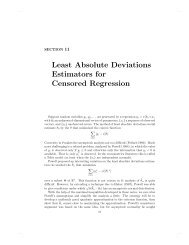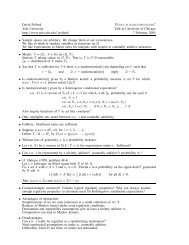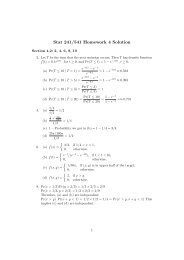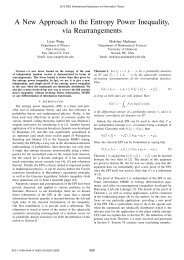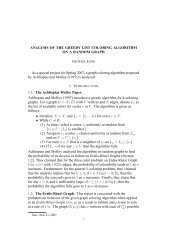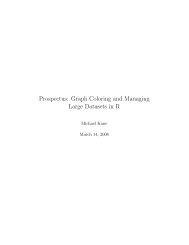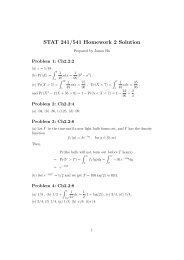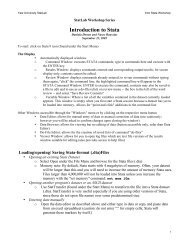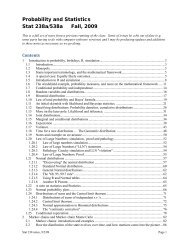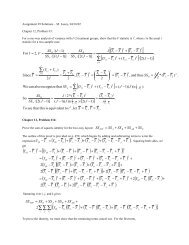Slides
Slides
Slides
You also want an ePaper? Increase the reach of your titles
YUMPU automatically turns print PDFs into web optimized ePapers that Google loves.
1<br />
Variable Selection Using the Dantzig Selector:<br />
Theoretical Properties and Extensions<br />
Lee Dicker and Xihong Lin<br />
Department of Biostatistics<br />
School of Public Health<br />
Harvard University<br />
March, 2009<br />
Xihong Lin
2<br />
Outline<br />
• Motivation<br />
• Dantzig Selector (DZ)<br />
• Large Sample Properties of Dantzig Selector<br />
• Adaptive (Doubly Weighted) Dantzig Selector<br />
• Relationship of Adaptive DS and Adaptive LASSO<br />
• Simulation Studies<br />
• Conclusions<br />
March, 2009<br />
Xihong Lin
3<br />
Motivation: ”Omics” Data in Population-Based Studies<br />
• The rapid advance of biotechnology yields massive<br />
high-throughput ”omics” data.<br />
• Examples include genomics, epigenomics, proteomics,<br />
metabolomics,· · · , X-omics.<br />
• Such ”omics” technology has been applied rapidly to<br />
population-based studies to study interplay of gene and<br />
environment in causing human diseases.<br />
March, 2009<br />
Xihong Lin
4<br />
Motivation: ”Omics” Data in Population-Based Studies<br />
• In genome-wide assocation studies, a million SNP markers are<br />
genotyped across the genome to study the association of<br />
common genetic variants and disease phenotypes (case/control<br />
status).<br />
• The massive whole genome-wide sequencing data are rapidly<br />
available, e.g., the 1000 genome project, to study the effects of<br />
rare variants.<br />
March, 2009<br />
Xihong Lin
5<br />
Motivation<br />
• Variable selection is of significant interests in current<br />
biomedical ”omics” studies.<br />
• Common variable selection approaches are penalized likelihood<br />
based, e.g., LASSO, adaptive LASSO and SCAD.<br />
• The Dantzig selector (DS; Candes and Tao, 2007) can be<br />
viewed as an estimating equation based variable selection<br />
procedure and is particularly appealing for longitudinal data.<br />
• Little is known about the asymptotic properties of the DS.<br />
• Focus of this talk (Independent data):<br />
(1) Large sample properties of the DS. (2) Propose Adaptive<br />
DS. (3) Connection with Adaptive Lasso.<br />
March, 2009<br />
Xihong Lin
6<br />
Example: GWAS on Childhood Neuro-development in Mexico<br />
• n = 1000 newborns<br />
• 620,000 SNP markers (0,1,2) across the genome<br />
• Outcome: Baylor score of neurodevelopment at 12 months .<br />
• Interested in studying which genes are associated with early<br />
childhood neuro-development and gene-metal exposure<br />
interactions.<br />
March, 2009<br />
Xihong Lin
7<br />
Model Setup<br />
Model:<br />
y i = X T i β + ǫ i ,<br />
where X i =covariates (p × 1) and β=regression coefficients (p × 1)<br />
and E(ǫ i ) = 0 and E(ǫ 2 i ) = σ2 .<br />
Problem:<br />
• Suppose the true set of non-zero βs: T ∗ = {j : β j ≠ 0}.<br />
• Goal: Identify T ∗ and estimate β T = {β j } j∈T ∗.<br />
March, 2009<br />
Xihong Lin
8<br />
Penalized Likelihoods and Lasso<br />
• Penalized likelihood: Simultaneous model selection and<br />
estimation.<br />
– Maximize<br />
−log(likelihood) + sparseness penalty,<br />
• Lasso<br />
1<br />
min<br />
β 2 ||y − Xβ||2 2 + λ||β|| 1 . (lasso)<br />
March, 2009<br />
Xihong Lin
9<br />
Dantzig Selector<br />
• Idea: Rather than controlling the size of residuals, the Dantzig<br />
selector is based on the normal score equations and controls the<br />
correlation of residuals with X:<br />
minimize ||β|| 1<br />
subject to ||X ′ (y − Xβ)|| ∞ ≤ λ.<br />
(DS)<br />
• Candes and Tao (2007) and Bickel al (2008) studied finite<br />
sample properties.<br />
• The Dantzig selector and Lasso are closely related (Efron et al.,<br />
2007; James, et al., 2008).<br />
• Little is known about the large sample properties of the DS.<br />
March, 2009<br />
Xihong Lin
10<br />
Questions<br />
• Question(s) 1:<br />
Is the Dantzig selector consistent for estimation? What is its<br />
asymptotic distribution?<br />
• Question 2:<br />
Is the Dantzig selector consistent for model selection? i.e., is<br />
lim P( ˆT = T ∗ ) = 1?<br />
n→∞<br />
• Answers to Questions 1 and 2 depend heavily on choice of λ.<br />
• When does the Dantzig selector have a unique solution?<br />
March, 2009<br />
Xihong Lin
11<br />
Uniqueness and the Dantzig Selector<br />
D<br />
β^<br />
|| β^ || 1 B 1<br />
• The DS feasible set: D = {β; ||X ′ (y − Xβ)|| ∞ ≤ λ}<br />
• If D is not parallel to the closed L 1 -unit ball, B 1 , then the<br />
Dantzig selector has a unique solution.<br />
• If X i are iid then the Dantzig selector has a unique solution<br />
with probability 1.<br />
March, 2009<br />
Xihong Lin
12<br />
Asymptotic Properties of the Dantzig Selector<br />
• If C = lim n→∞ n −1 X T X is not parallel to the L 1 -ball.<br />
• Asymptotic Limit: If λ/n → c 0 and c 0 ∈ [0, ∞], then ˆβ P → β ∗ ,<br />
where β ∗ is the true value of β and β 0 solves<br />
minimize ||β|| 1<br />
subject to ||C(β ∗ − β)|| ∞ ≤ c 0 .<br />
March, 2009<br />
Xihong Lin
13<br />
Asymptotic Properties of the Dantzig Selector<br />
• If λ/ √ n → c 1 and c 1 ∈ [0, ∞), then √ n(ˆβ − β ∗ ) D → u 0 , where<br />
u 0 solves<br />
minimize ∑ j∈T ∗ sgn(β ∗ j )u j + ∑ j /∈T ∗ |u j |<br />
subject to ||C(v − u)|| ∞ ≤ c 1 ,<br />
and v ∼ N(0, σ 2 C −1 ).<br />
• Model Selection Inconsistency: There exist a large class of<br />
matrices C for which the Dantzig selector is not consistent for<br />
model selection, regardless of λ.<br />
March, 2009<br />
Xihong Lin
14<br />
Adaptive (Doubly Weighted) Dantzig Selector<br />
• Ideas:<br />
– When we suspect β j = 0, relax the constraint on the j-th<br />
score equation and heavily penalize non-zero β j .<br />
– When we suspect β j ≠ 0, Nearly solve the j-th scoring<br />
equation and only moderately penalize non-zero β j<br />
• Adaptively Dantzig Selector (ADS)<br />
minimize<br />
∑ n<br />
j=1 w j|β j |<br />
subject to |X ′ j (y − Xβ)| ≤ w jλ, j = 1, ..., p.<br />
(ADS)<br />
e.g., w j = |β LS<br />
j | −γ for some γ > 0.<br />
March, 2009<br />
Xihong Lin
15<br />
Adaptive Dantzig Selector<br />
Dantzig Selector<br />
β * + C −1 B ∞<br />
β^<br />
|| β^ || 1 B 1<br />
Doubly Weighted Dantzig Selector<br />
β * + C −1 W B ∞<br />
β^<br />
|| W β^ || 1 W −1 B 1<br />
DWDS, n = ∞<br />
β^ = β *<br />
β * + C<br />
|| 1 W −1 ∞ B 1 || W ∞ β^<br />
March, 2009<br />
Xihong Lin
16<br />
Weighted Dantzig Selector: Asymptotics<br />
• Suppose that √ nw j /λ = O P (1) if j ∈ T ∗ and √ nw j /λ → ∞<br />
if j /∈ T ∗ .<br />
• Model Selection Consistency: The adaptive Dantzig<br />
selector(ADS) is consistent for model selection:<br />
lim P( ˆT = T ∗ ) = 1,<br />
n→∞<br />
• Orcale Properties: The ADS estimators are asymptotically<br />
equivalent to the OLS estimator of β ∗ based on the true model<br />
T ∗ :<br />
√ n(ˆβT ∗ − β ∗ T ∗ ) D → N(0, σ 2 C −1<br />
T ∗ ,T ∗ ).<br />
March, 2009<br />
Xihong Lin
17<br />
Adaptive Dantzig Selector and Adaptive Lasso<br />
• Adaptive LASSO:<br />
1<br />
min<br />
β 2 ||y − Xβ||2 2 + λ<br />
p∑<br />
j=1<br />
w j |β j |.<br />
(alasso)<br />
• Adaptive DS and Adaptive LASSO have the same asymptotic<br />
properties.<br />
March, 2009<br />
Xihong Lin
18<br />
Adaptive Dantzig Selector and Adaptive Lasso<br />
• Set β 0 = Wβ and X 0 = XW −1 , we have<br />
minimize ||β 0 || 1<br />
subject to ||X ′ 0(y − X 0 β 0 )|| ∞ ≤ λ<br />
(ADS)<br />
and<br />
1<br />
min<br />
β 0 2 ||y − X 0β 0 || 2 2 + λ||β 0 || 1 (ALASSO)<br />
• This implies ADS and DS have the same computational cost<br />
and one can implement ADS using DASSO.<br />
March, 2009<br />
Xihong Lin
19<br />
Estimation of the Toning Parameter λ<br />
• Degrees of Freedom for the Danzig Selection:<br />
ˆdf(λ) = trace{X T (X ′ EX T ) −1 X E } = |T |,<br />
where E = {j; |X ′ j {y − X ˆβ}| = λ} and let T = {j; ˆβj ≠ 0}.<br />
• BIC for DS and ADS:<br />
min<br />
β<br />
(nσ 2 ) −1 ||y − X ˆβ|| 2 2 + n −1 log(n) ˆdf(λ).<br />
• If w j = |ˆβ j (OLS)| −1 and λ is chosen to minimize the BIC , then<br />
the ADS is<br />
(i) consistent for model selection and<br />
(ii) asymp. equiv to β ∗ LS based on the true model, T ∗ .<br />
March, 2009<br />
Xihong Lin
20<br />
Simulations<br />
• Compare DS, adatpive DS, LASSO and Adaptive LASSO<br />
• For adaptive DS (ADS) and Adaptive LASSO: w j = |ˆβ j<br />
OLS | −1<br />
• Implementation:<br />
– LARS (Efron, et al., 2004) for lasso and alasso.<br />
– DASSO (an extension of LARS; James, et al., 2008) for<br />
Dantzig selector and ADS.<br />
– Both LARS and DASSO efficiently obtain estimates for all<br />
values of λ.<br />
• λ chosen to minimize prediction error using validation data<br />
(Data validation (DV)) and BIC.<br />
March, 2009<br />
Xihong Lin
21<br />
Simulation Settings<br />
• Simulation settings:<br />
β 0 = (3, 1.5, 0, 0, 2, 0, 0, 0) ∈ R 8 ,<br />
X = (x ij ), x ij ∼ N(0, 1), corr(x ij , x ij ′) = 0.5 |j−j′| , i ≠ j,<br />
with independent rows.<br />
• Noise levels σ = 1.<br />
• Number of observations: n = 50.<br />
• 500 runs.<br />
March, 2009<br />
Xihong Lin
22<br />
Simulation Results<br />
Tuning Estimation Sq. Error Model Error Model Size F+ F − Exact<br />
DV DS 0.17 0.12 5.69 2.69 0.00 0.07<br />
ADS 0.11 0.08 3.91 0.91 0.00 0.54<br />
LASSO 0.17 0.12 5.70 2.70 0.00 0.07<br />
ALASSO 0.11 0.09 4.01 1.01 0.00 0.50<br />
BIC DS 0.19 0.15 4.08 1.08 0.00 0.34<br />
ADS 0.12 0.09 3.22 0.22 0.00 0.83<br />
LASSO 0.18 0.14 4.10 1.10 0.00 0.34<br />
LASSO 0.12 0.09 3.23 0.23 0.00 0.83<br />
March, 2009<br />
Xihong Lin
23<br />
Concluding Remarks<br />
• Adaptive DS has advantages over the Dantzig selector:<br />
consistency in model selection and orcale properties, parallel<br />
adaptive LASSO.<br />
• ADS outperforms DS in finite sample simulation studies.<br />
• More complex extensions of the Dantzig selector are possible.<br />
LASSO −→ PL with penalty p λ<br />
Dantzig selector −→<br />
p λ -Dantzig selector<br />
• Implementation and theory are more difficult with p λ -DS.<br />
• Extensions to generalized linear models and longitudinal data<br />
using estimating equations are in progress .<br />
March, 2009<br />
Xihong Lin



